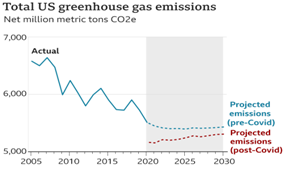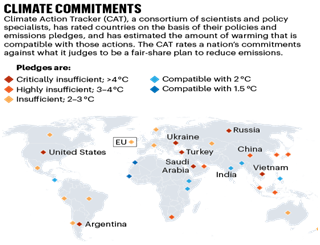

The United States has officially withdrawn from the Paris Agreement
Context
The United States has officially withdrawn from the Paris Agreement, the landmark international accord to keep climate change in check and limit future greenhouse gas emissions.
Background
- After a three-year delay, the US has become the first nation in the world to formally withdraw from the Paris climate agreement.
- President Trump announced the move in June 2017, but UN regulations meant that his decision only takes effect from now onwards.
- The delay is down to the complex rules that were built into the Paris agreement to cope with the possibility that a future US president might decide to withdraw the country from the deal.
- The US could re-join it in future, should a president choose to do so.
Analysis
What is Paris Agreement?
- The landmark deal, struck in 2015, aims to limit global warming to “well below” 2 °C above pre-industrial temperatures.
- The agreement came into force on November 4, 2016 and 189 countries have adopted it.
- The Paris accord requires countries to set their own voluntary targets for reducing greenhouse gases such as carbon dioxide, and to steadily increase those goals every few years.
- The only binding requirement is that nations have to accurately report on their efforts.
- Crucially, under the Paris agreement countries for the first time had declared national action plans known as ‘Intended Nationally Determined Contributions’ (INDC) outlining targets to cut greenhouse gas emissions.
- Though these are not legally binding, they are based on the principle of Common but Differentiated Responsibilities (CBDR), recognising that the obligations of developing countries have to be viewed in the context of their economic and social limitations.
- Under the agreement, developed countries had also made key commitments to provide finances for the Green Climate Fund, established under the United Nations Framework Convention on Climate Change (UNFCCC).
- This body approves funding for projects in countries that are vulnerable to the impacts of climate change in the form of storms, heat waves and extreme rainfall.
What is the concern?
- The U.S. is currently the second-highest greenhouse gas emitter in the world.
- It’s responsible for spewing more than 5 billion metric tons of carbon dioxide a year since 1990, to say nothing of other potent planet-warming gases, such as methane or hydrofluorocarbons.

- The country is number one in overall “historical” emissions, however: the source of 25 percentof all human-produced greenhouse gases that have collected in the atmosphere since the Industrial Revolution.
- The U.S. is now the only major country in the world not committed to the accord, which aims to keep global temperatures from rising more than 3.6 degrees Fahrenheit (2 degrees Celsius) above pre-industrial temperatures.
Which countries are taking the lead on climate-change mitigation?
China and the European Union have picked up the pieces.
- China to become carbon neutral (by 2060): In September, China, the world’s top emitter of greenhouse gases, announced a bold plan to make its economy carbon neutral by 2060, using a combination of renewable energy, nuclear power and carbon capture.
- EU’s Green Deal: Likewise, the EU’s Green Deal, first announced in December 2019, sets out a road map for making the bloc carbon neutral by 2050. Compared with 1990 levels, the EU has already reduced its greenhouse-gas emissions by 24%. Legislation intended to achieve full carbon neutrality by the middle of the century is under discussion.

- Other major economies, such as Japan and South Korea, pledged last month to become carbon neutral by 2050, but haven’t spelt out in detail how they will achieve it.
- In all, more than 60 countries worldwide — including all EU member states except Poland — have committed to achieving net-zero emissions by mid-century.
What will the withdrawal mean in practice?
- While the US now represents around 15% of global greenhouse gas emissions, it remains the world's biggest and most powerful economy.
- So when it becomes the only country to withdraw from a global solution to a global problem it raises questions of trust.
- Although this has been a long time coming, there is still a palpable sense of disappointment for many Americans who believe that climate change is the biggest global challenge and the US should be leading the fight against it.
- The formal withdrawal has also re-opened old wounds for climate diplomats.
What does this mean for India and its efforts to fight climate change?
- In 2015, India played a crucial role in shaping the agreement through the BRICS (Brazil, Russia, India, China, South Africa) and LMDC (Like-Minded Developing Countries) country groups.
- In October 2015, ahead of the annual Conference of Parties in Paris, India had announced its ambitious INDCs.
- It pledged a reduction in its emissions intensity of its Gross Domestic Product by 33 to 35 per cent by 2030, below 2005 levels.
- Crucially, it announced that by 2030, it would increase the share of non-fossil fuels in the installed energy capacity to 40 per cent.
- Further, it set a target of creating an additional carbon sink to absorb 2.5 to 3 billion tonnes of carbon dioxide by increasing its forest and tree cover by 2030.
- India’s climate action goals will continue as per plan even as they termed the US exit as a move that would lead to problems in cutting emissions globally.
How will it impact the climate?
- The world has already warmed 1.2 degrees Celsius (2.2 degrees Fahrenheit) since pre-industrial time, so the efforts are really about preventing another 0.3 to 0.7 degrees Celsius (0.5 to 1.3 degrees Fahrenheit) warming from now.
- “Having the U.S. pull out of Paris is likely to reduce efforts to mitigate, and therefore increase the number of people who are put into a life-or-death situation because of the impacts of climate change: this is clear from the science,
What’s next now?
- Parties to the Paris accord have agreed to update their targets for 2030 in line with the latest evidence on the world’s remaining carbon budget.
- A special report from the Intergovernmental Panel on Climate Change (IPCC) on keeping warming to 1.5 °C, completed in 2018, made clear that the climate targets that countries think they can meet are not sufficient to halt global warming.
- All remaining parties to the agreement must submit their new 2030 targets before the next major United Nations climate meeting, set to take place in Glasgow, UK, in November 2021.
- The US withdrawal, if it is sustained by the next administration, will inevitably cause some countries to reduce their level of effort on implementing existing commitments.
Conclusion
Climate change is a very important issue and world action is needed. The world leaders need to come forward and be compliant with the Paris Agreement.


